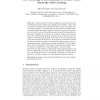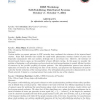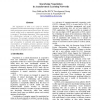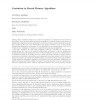19 search results - page 3 / 4 » Asynchronous Group Mutual Exclusion in Ring Networks |
DCOSS
2010
Springer
13 years 5 months ago
2010
Springer
Synchronization is widely considered as an important service in distributed systems which may simplify protocol design. Phase clock is a general synchronization tool that provides ...
OPODIS
2004
13 years 6 months ago
2004
S (in alphabetic order by speaker surname) Speaker: Uri Abraham (Ben-Gurion University) Title: Self-Stabilizing TimeStamps : Speaker: Anish Arora (Ohio State) Title: Self-Stabilizi...
HICSS
2003
IEEE
13 years 10 months ago
2003
IEEE
The negotiation of what is to count as mutually acceptable collaborative knowledge is difficult to conduct when participants cannot interact face-to-face. We review certain relate...
GLOBECOM
2007
IEEE
13 years 11 months ago
2007
IEEE
— An opportunistic large array (OLA) is a form of cooperative diversity in which a large group of simple, inexpensive relays or forwarding nodes operate without any mutual coordi...
STOC
1993
ACM
13 years 9 months ago
1993
ACM
Most complexity measures for concurrent algorithms for asynchronous shared-memory architectures focus on process steps and memory consumption. In practice, however, performance of ...




